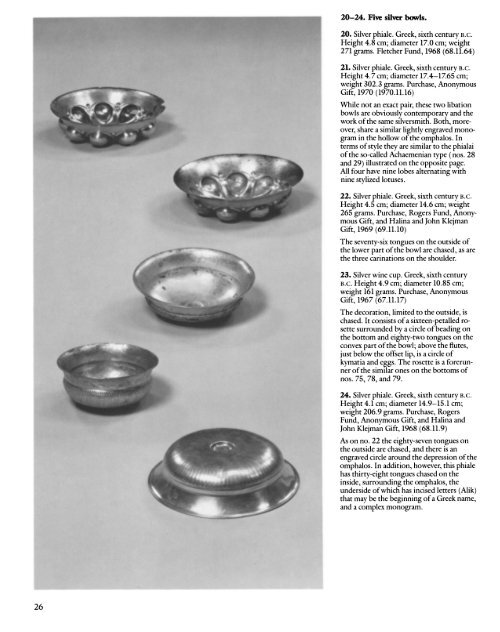A Greek and Roman Treasury: The Metropolitan Museum of Art ...
A Greek and Roman Treasury: The Metropolitan Museum of Art ...
A Greek and Roman Treasury: The Metropolitan Museum of Art ...
You also want an ePaper? Increase the reach of your titles
YUMPU automatically turns print PDFs into web optimized ePapers that Google loves.
20-24. Five silver bowls.<br />
20. Silver phiale. <strong>Greek</strong>, sixth century B.C.<br />
Height 4.8 cm; diameter 17.0 cm; weight<br />
271 grams. Fletcher Fund, 1968 (68.11.64)<br />
21. Silver phiale. <strong>Greek</strong>, sixth century B.C.<br />
Height 4.7 cm; diameter 17.4-17.65 cm;<br />
weight 302.3 grams. Purchase, Anonymous<br />
Gift, 1970 (1970.11.16)<br />
While not an exact pair, these two libation<br />
bowls are obviously contemporary <strong>and</strong> the<br />
work <strong>of</strong> the same silversmith. Both, moreover,<br />
share a similar lightly engraved monogram<br />
in the hollow <strong>of</strong> the omphalos. In<br />
terms <strong>of</strong> style they are similar to the phialai<br />
<strong>of</strong> the so-called Achaemenian type (nos. 28<br />
<strong>and</strong> 29) illustrated on the opposite page.<br />
All four have nine lobes alternating with<br />
nine stylized lotuses.<br />
22. Silver phiale. <strong>Greek</strong>, sixth century B.C.<br />
Height 4.5 cm; diameter 14.6 cm; weight<br />
265 grams. Purchase, Rogers Fund, Anonymous<br />
Gift, <strong>and</strong> Halina <strong>and</strong> John Klejman<br />
Gift, 1969 (69.11.10)<br />
<strong>The</strong> seventy-six tongues on the outside <strong>of</strong><br />
the lower part <strong>of</strong> the bowl are chased, as are<br />
the three carinations on the shoulder.<br />
23. Silver wine cup. <strong>Greek</strong>, sixth century<br />
B.C. Height 4.9 cm; diameter 10.85 cm;<br />
weight 161 grams. Purchase, Anonymous<br />
Gift, 1967 (67.11.17)<br />
<strong>The</strong> decoration, limited to the outside, is<br />
chased. It consists <strong>of</strong> a sixteen-petalled rosette<br />
surrounded by a circle <strong>of</strong> beading on<br />
the bottom <strong>and</strong> eighty-two tongues on the<br />
convex part <strong>of</strong> the bowl; above the flutes,<br />
just below the <strong>of</strong>fset lip, is a circle <strong>of</strong><br />
kymatia <strong>and</strong> eggs. <strong>The</strong> rosette is a forerunner<br />
<strong>of</strong> the similar ones on the bottoms <strong>of</strong><br />
nos. 75, 78, <strong>and</strong> 79.<br />
24. Silver phiale. <strong>Greek</strong>, sixth century B.C.<br />
Height 4.1 cm; diameter 14.9-15.1 cm;<br />
weight 206.9 grams. Purchase, Rogers<br />
Fund, Anonymous Gift, <strong>and</strong> Halina <strong>and</strong><br />
John Klejman Gift, 1968 (68.11.9)<br />
As on no. 22 the eighty-seven tongues on<br />
the outside are chased, <strong>and</strong> there is an<br />
engraved circle around the depression <strong>of</strong> the<br />
omphalos. In addition, however, this phiale<br />
has thirty-eightongues chased on the<br />
inside, surrounding the omphalos, the<br />
underside <strong>of</strong> which has incised letters (Alik)<br />
that may be the beginning <strong>of</strong> a <strong>Greek</strong> name,<br />
<strong>and</strong> a complex monogram.<br />
26

















